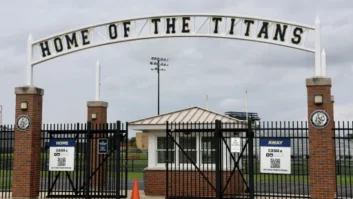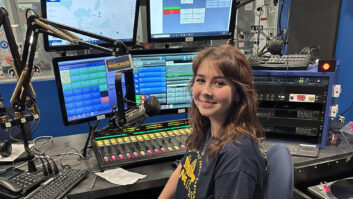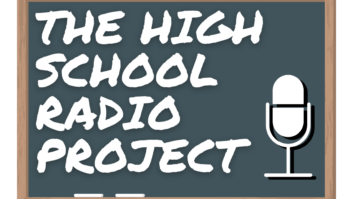
Cally Arnettin the air studio. A few years ago, Radio World published an article about my adventures building a bootleg radio station in Indiana.
In the spring of 1960, a little one-tube phone oscillator kit from Allied Radio got me into trouble. With the help of a couple high school buddies I strung an antenna from an electrical power pole in my backyard to the top of a church steeple. We launched WKPB — “Knightstown Panthers are the Best” — and would spend two or three hours a couple times a week playing 45 rpm rock ’n’ roll records and gossiping about school events.
We thought it was pretty cool how our little station could radiate a signal all around the community. Classmates were tuning in.
An FCC field engineer saw nothing amazing about what we were doing to the AM spectrum. Our signal was riding on top of Indianapolis WIBC’s 50 kW signal all the way to Cincinnati. The engineer shut us down and took our phone oscillator, and it was the end of “WKPB — 1610 on your AM dial.”
After a couple years of technical college, I landed a job with the broadcast division of Sarkes Tarzian Corp. When not creating schematic drawings or writing technical manuals about stereo multiplex FM transmitters, I finagled my way into a gig as a substitute disk jockey at the local Tarzian-owned FM station. That’s how my real (and legal) studio adventures began.
Now fast-forward 50 years. In 2011 an invitation arrived for a Knightstown High School Class of 1961 reunion. Some of my classmates knew I’d been producing television content and asked if I’d create a time-capsule video to show. I could grab an ENG camera and drive down to K-town, shoot footage and put together a story. I Googled Knightstown to see what was out there about my old stomping grounds. As I was reading the listings, up popped call letters: “WKPW(FM): Knightstown’s classic hits station.”
Knightstown has its own station … and the call letters are WKPW? My bootleg station was WKPB! Do their call letters stand for Knightstown Panthers always Win? It was a lightning bolt through my head. What started as an information-gathering session became a compelling need to check out the station. My first stop back in Knightstown was at the studios.
Starting with the basics
WKPW is a student-run noncommercial station operated by the New Castle Area Career Programs; it has been broadcasting since September 1993. It began with a seven-hour daily schedule and 250 watts. Today it runs 24 hours with a BE AudioVault automation system and carries a 4,400 watt punch. Originally the facilities were at the Indiana Soldiers and Sailors Children’s Home; the transmitter and tower remain there today.

Shown doing production work is Jennifer Farrington. In spring of 2011, the studio relocated into the new Knightstown High School facility. This noncom is like no school station I have visited.
Mike York, program director and instructor at WKPW, is a skilled electrical/mechanical guy with years of broadcast experience, a “hands-on, make-it-happen” personality who loves to motivate kids to do remarkable things. He led the effort to create a facility that included a lobby, air studio, three production rooms, classroom, office, rack room, microwave link and RPU.
He started by creating a floor plan with Auto-CAD showing where walls fit together, where the studs are to be spaced, windows positioned and doors hung. He held an unusual classroom session for students who have signed up for vocational courses in radio broadcasting. He brought in donuts (on his dime) and explained that this year’s course work would include something different: Students would have the opportunity to build a radio studio.
He showed the floor plan and described what the studio would look like; he sold them on the idea that this studio would be a showcase for the school and community. The labor was not going to pay a penny; it would be part of their course work, three hours a day. He guaranteed they’d have fun, learn skills and eat lots of donuts. The donuts got attention.
The next day Mike was off to city hall to get permits and line up building contractors to perform work that he and his students could not. He worked with contractors to procure the best supplies and rates. When students showed up, Mike began by teaching them how to read a tape measure — 1 inch, 1/4 inch, 1/32 — and the mathematical calculation and fractional differences. He showed them how to use a saw guide and cut boards safely. He taught them how to build studio walls 10 feet high and 8 inches thick and fill them with sound insulation.
The students framed in the walls. The stronger ones helped Mike hang the heavy studio doors. Contractors performed electrical work, ran the conduit and installed the HVAC. Most of the contractors were local residents who went out of their way with the job.
Windows and ceiling tiles were installed and ceiling lights turned on. Paint brushes came out and the studio began to take on luster. Carpet arrived and contractors laid it on the floors and some on the production room walls. Mike showed the students how to make air flow noise baffles.

Mike York Equipment from the old studio was moved, one truck- or car-load at a time. Studio furniture and audio equipment, some old some new, was set up and connected. The new Moseley STL arrived and was added to the racks. The directional antenna was mounted on the studio mast and dialed in on the transmitter site two miles away. At the transmitter, the receiving antenna was mounted and coax fed to the new receiver.
The studio began operation on May 24–26, 2011.
Donuts are expensive
The basics were in place. The station’s Internet streaming was up and running, AudioVault had been programmed and audio was feeding the STL. The students began producing local news, community events, weather reports, station ID and school activities from one of the new production rooms. There was still work to be completed, and the school year ended two weeks later.
At this point it would have been easy to pospone remaining work until fall but Mike wanted the studio finished by start of the school year. He continued working all summer, 70 days including weekends and holidays, 10 to 14 hours each day. Mike is a salaried teacher; he is not paid for summer work activity, nor does he receive overtime. Perhaps the Kingston Trio music coming across the new lobby speaker system best describes Mike’s dedication:
Charlie’s wife goes down
To the Scollay Square station
Every day at quarter past two
And through the open window
She hands Charlie a sandwich
As the train comes rumblin’ through.
At the start of fall semester, returning students signed up for Radio Broadcasting I and II, new students signed up for Beginning Radio Broadcasting. It was a new year and a whole new radio studio.
When the bills arrived and everything was tallied and accounted, the project came in just under the school board-approved $135,000. (The bill for donuts is unknown but according to Mike, it was a lot.)
In May 2012 the station completed its first year in the new studio. It recently was honored with an award from the Indiana Association of School Broadcasters.
This fall students will again be busy learning fundementals of broadcasting at a best-in-class radio studio with station call letters WKPW.It sure beats the one-tube phone oscillator station of 50 years ago that a few students at Knightstown High School built and called WKPB.
To read the author’s 2008 article “The Story of Bootleg Radio 1610,”visit radioworld.com/links.
Key Gear, Old and New
Air Studio
Audioarts R90 Console
Electro-Voice RE20 Microphones
Crown power amp
JBL monitors
dbx microphone processors
Marti remote system
Sage EAS
BE Audio Vault 2 Digital Storage System
Dell monitors
Adobe Audition 2.0 software
Gateway Touch Screen News Computers
24-inch Dell Monitors
Adobe Audition 2.0
50-inch HD Phillips LCD TV
The production and recording rooms have similar equipment to the above, with Shure SM 7B Microphones and Symetrix 528E Microphone Processors. The recording studio uses a Mackie mixer.
RF & Misc Equipment
Broadcast Electronics STX LP 1 kW Transmitter
Broadcast Electronics Exciter (backup)
Orban Optimod-FM 8100A
Orban 8100A/XT2 Limiter
Belar FM modulation monitor
Belar stereo monitor
Audioarts distribution amplifier
Broadcast Tools switcher
Moseley STL transmitter & receiver
ART Pro VLA II leveling amplifier
Rolls tuner
Inovonics modulation analyzer
HP ProCurve network hub/switch
Arbitron PPM encoder & encoding monitor
Ortronics phone Cat-5 panel
Sine Systems transmitter remote control






